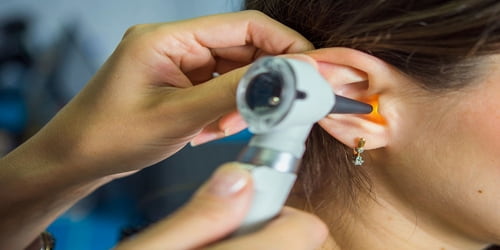Otitis Media (Diagnosis, Treatment, and Preventions)
Definition: Otitis media, also called a middle ear infection that is most common in infants and young children, especially those between the ages of 6 months and 3 years. It is an inflammation of the middle ear and can occur in either one or both ears at the same time. The two main types are acute otitis media (AOM) and otitis media with effusion (OME).
Most middle ear infections occur during the winter and early spring. Often, middle ear infections go away without any medication. However, people should seek medical treatment if pain persists or they have a fever.
Although a middle ear infection can occur at any age, it’s much less common in older children and adults. Ear infections do not spread from person to person and they most commonly occur with a cold. Antibiotics are often used to treat ear infections, but in certain circumstances, a doctor may suggest waiting for 2 to 3 days before starting antibiotics.
1 in 10 children suffers from otitis media annually. This is 10 times the amount of adults who suffer from the same condition annually. Otitis media is one of the most common reasons for children below the age of 4 with a fever to visit a general practitioner. It composes 8% of all childhood disease and accounts for 1.3% of presentations to general practice.
Chronic otitis media with effusion interferes with the hearing of approximately 5% of 5-year-olds.

Diagnosis and Treatment of Otitis media: As its typical symptoms overlap with other conditions, such as acute external otitis, clinical history alone is not sufficient to predict whether acute otitis media is present; it has to be complemented by visualization of the tympanic membrane.
From a visual examination inside the ear with an otoscope (a lighted instrument for looking inside the ear) and description of the symptoms, your doctor can diagnose otitis media. In an infected ear, the eardrum usually appears red and swollen and pus may be seen behind the eardrum, which is usually clear and translucent.
The doctor might also conduct a test called tympanometry to determine whether the middle ear is working properly. For this test, a device is put inside the patient’s ear canal, changing the pressure and making the eardrum vibrate. The test measures a change in vibration and records them on a graph. This is a simple hearing test that measures the pressure on both sides of the eardrums.
Most people with otitis media respond well to general measures such as pain relief and increased fluid intake. There are a number of ways to treat middle ear infections. The doctor will base treatment on people’s child’s age, health, and medical history.

Antibiotics have been shown to have little effect on the course of acute otitis media, and they are not used in all circumstances.
In children without fever and vomiting, antibiotics are not given unless the child’s symptoms have not resolved within 2 days, or unless the child is less than 2 years of age.
In children with fever and vomiting, antibiotics are generally given. Amoxycillin is the antibiotic of choice.
Antihistamines may help people who have allergies and ear infections. But no medications other than antibiotics will cure the ear infection if it’s caused by bacteria. Pain relievers (e.g., acetaminophen*, ibuprofen) can be used to ease the pain of the infection and to lower a child’s fever.
An operation called myringotomy – a minor surgical incision – can be necessary. During the operation, the eardrum is opened to remove the fluid. A small ventilation tube can also be placed in the incision. Normally, the operation immediately results in better hearing.
Adults can also contract otitis media, and the treatment is the same as for children. The severity of the symptoms and the age of the patient determines the likelihood of success of antibiotic treatment.
Preventions of Otitis media: It’s hard to prevent ear infections since many children, especially those who attend daycare, are susceptible to colds. Careful hand-washing regimens can help reduce the chance of catching colds, so it’s important to remind people’s kids to wash up as often as possible.
There are ways to lower people’s child’s risk of getting ear infections:
- Wash people’s hands and their child’s hands frequently.
- If they bottle feed, always hold their baby’s bottle them self and feed them while they’re sitting up or semi-upright. Wean them off the bottle when they turn 1 year old.
- Avoid smoky environments.
- Keep their child’s immunizations up-to-date.
- Wean people’s child from the pacifier by the time they are 1 year old.
Breastfeeding seems to lower the chances of developing ear infections among infants and children by helping to boost their immunity. Another good preventative measure is to keep your home smoke free as exposure to second-hand smoke increases the risk of middle ear infections. Immunization with the pneumococcal vaccine can lessen the likelihood of getting ear infections caused by certain types of bacteria.
Evidence does not support zinc supplementation as an effort to reduce otitis rates except maybe in those with severe malnutrition such as marasmus.
Information Source:
















